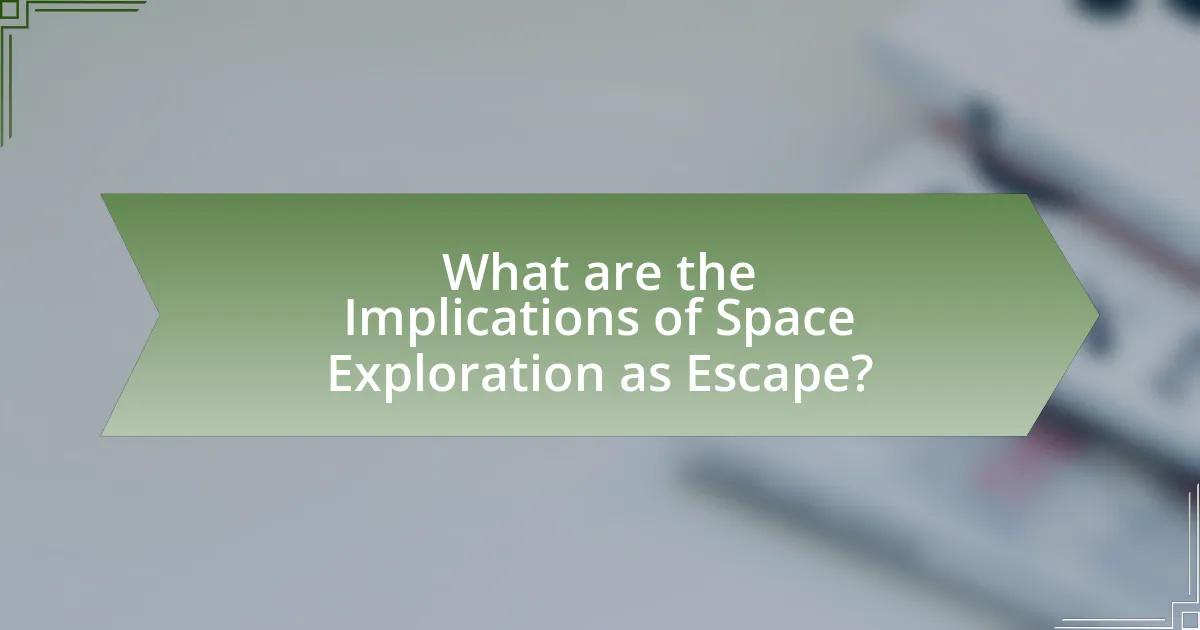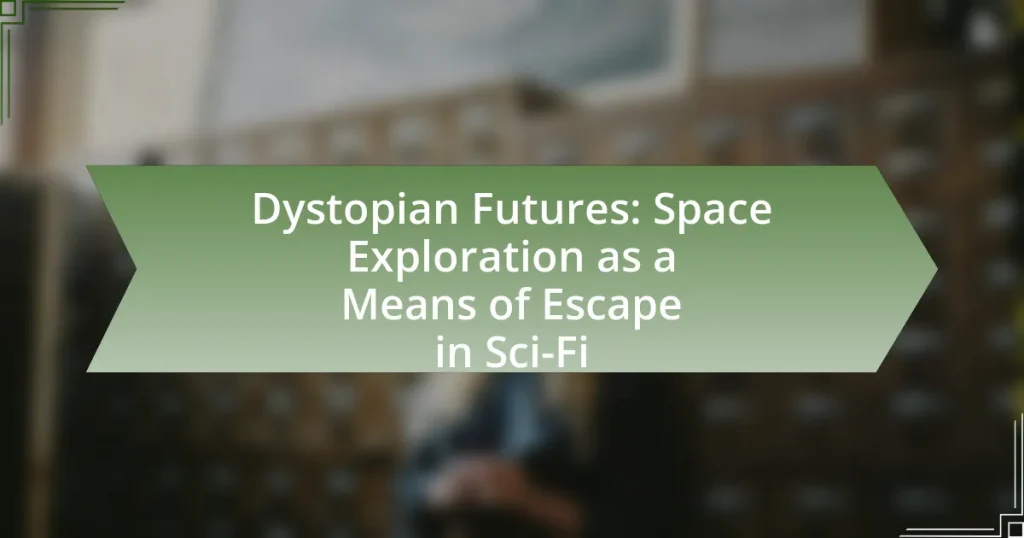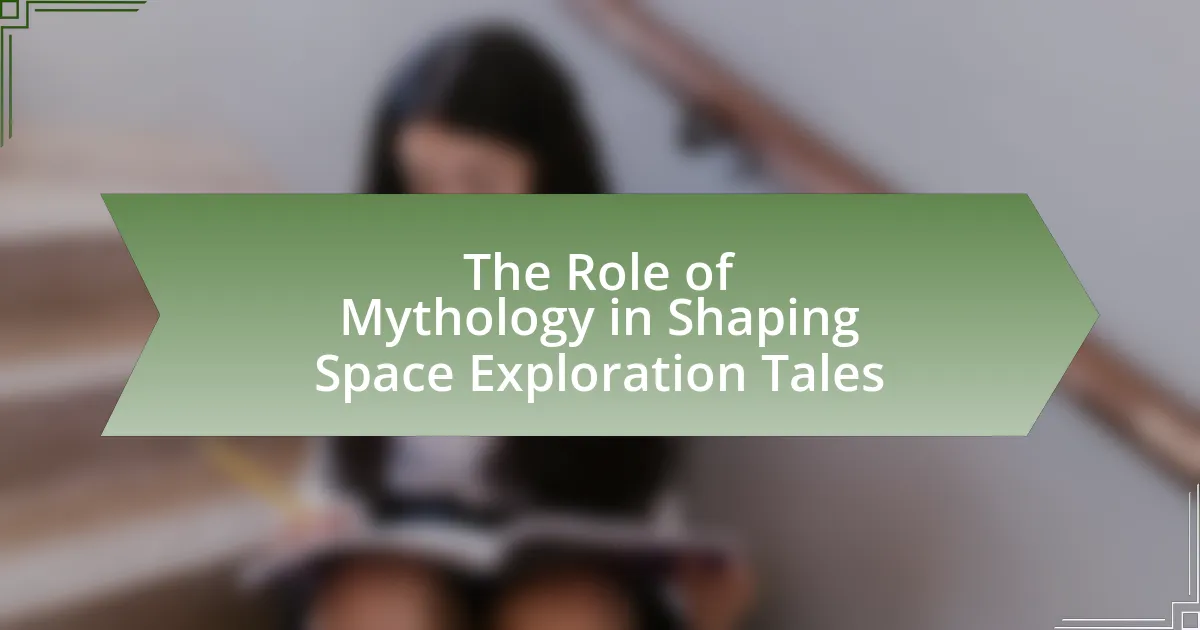Dystopian futures in science fiction depict societies marked by oppressive control, environmental degradation, and extreme inequality, serving as cautionary tales that reflect contemporary societal fears. This article explores how these narratives illustrate themes such as totalitarianism, technological overreach, and social inequality, while also examining the role of space exploration as a means of escape from deteriorating conditions on Earth. It discusses the motivations driving characters to seek refuge in space, the implications of such explorations, and the ethical considerations surrounding technological advancements. Additionally, the article highlights how these fictional portrayals can inform our understanding of current societal issues and provide practical insights for future space exploration endeavors.

What are Dystopian Futures in Sci-Fi?
Dystopian futures in sci-fi are speculative narratives that depict societies characterized by oppressive control, environmental degradation, or extreme inequality. These futures often serve as cautionary tales, reflecting contemporary societal fears and issues, such as totalitarianism, technological overreach, and loss of individual freedoms. Notable examples include George Orwell’s “1984,” which illustrates a surveillance state, and Aldous Huxley’s “Brave New World,” which explores the consequences of consumerism and genetic engineering. These works highlight the potential consequences of current trends, making them relevant to discussions about the future of humanity and the ethical implications of technological advancements.
How do dystopian futures reflect societal fears?
Dystopian futures reflect societal fears by illustrating the consequences of current social, political, and environmental issues. These narratives often depict scenarios where authoritarian regimes, technological overreach, or ecological disasters lead to a breakdown of society, mirroring contemporary anxieties about loss of freedom, surveillance, and climate change. For example, George Orwell’s “1984” highlights fears of totalitarianism and loss of individuality, while Margaret Atwood’s “The Handmaid’s Tale” addresses concerns about gender oppression and reproductive rights. Such representations serve as cautionary tales, prompting reflection on the potential trajectory of society if existing fears are not addressed.
What themes are commonly explored in dystopian narratives?
Common themes explored in dystopian narratives include totalitarianism, environmental degradation, technological control, loss of individuality, and social inequality. Totalitarianism is often depicted through oppressive governments that exert extreme control over citizens, as seen in George Orwell’s “1984.” Environmental degradation highlights the consequences of neglecting ecological balance, illustrated in works like “The Road” by Cormac McCarthy. Technological control is frequently portrayed through surveillance and manipulation, evident in “Fahrenheit 451” by Ray Bradbury. Loss of individuality is a recurring theme, where characters struggle against conformity, as shown in Aldous Huxley’s “Brave New World.” Lastly, social inequality is a critical focus, revealing class divides and exploitation, prominently featured in “The Hunger Games” series by Suzanne Collins. These themes collectively reflect societal fears and critiques, making dystopian narratives a powerful medium for exploring contemporary issues.
How do these themes relate to contemporary issues?
The themes of dystopian futures and space exploration as a means of escape in sci-fi relate to contemporary issues by reflecting societal anxieties about climate change, political instability, and technological advancement. For instance, the increasing frequency of natural disasters and geopolitical conflicts has led to discussions about the viability of colonizing other planets as a potential solution for humanity’s survival. Reports from organizations like NASA and the European Space Agency highlight ongoing research into Mars colonization, emphasizing the urgency of finding alternative habitats due to Earth’s deteriorating conditions. This connection illustrates how sci-fi narratives resonate with real-world concerns, prompting critical dialogue about our future and the ethical implications of space exploration.
Why is space exploration a recurring motif in dystopian fiction?
Space exploration is a recurring motif in dystopian fiction because it symbolizes humanity’s desire for escape from oppressive realities and the search for new beginnings. In narratives where Earth is often depicted as a decaying or hostile environment, space serves as a metaphor for hope and the possibility of a better future. For instance, in works like “The Martian” by Andy Weir and “Interstellar,” space exploration reflects the struggle against existential threats and the quest for survival beyond a deteriorating planet. This motif resonates with readers as it highlights the tension between human ambition and the consequences of technological advancement, illustrating the duality of exploration as both a potential salvation and a source of new challenges.
What historical context influences the portrayal of space exploration?
The portrayal of space exploration is significantly influenced by the historical context of the Cold War, particularly the Space Race between the United States and the Soviet Union. This period, marked by intense competition and technological advancements, led to a fascination with space as both a frontier for scientific discovery and a symbol of national superiority. The launch of Sputnik in 1957 and the Apollo moon landing in 1969 exemplified this rivalry, shaping public perception and inspiring a wave of science fiction that depicted space as a potential escape from dystopian realities on Earth. These events not only fueled imagination but also reflected societal anxieties about technology, war, and the future, embedding themes of exploration and escape in the narratives of the time.
How does space exploration symbolize hope or escape in these narratives?
Space exploration symbolizes hope or escape in dystopian narratives by representing the possibility of a better future beyond Earth’s deteriorating conditions. In these stories, characters often seek refuge in space as a means to escape oppressive regimes, environmental collapse, or societal decay. For example, in the film “Interstellar,” humanity’s survival hinges on finding a new habitable planet, illustrating the hope that space offers for a fresh start. This theme is further supported by the portrayal of advanced technology and the exploration of unknown worlds, which evoke a sense of wonder and potential for renewal. Such narratives emphasize that while Earth may be plagued by despair, the cosmos holds the promise of new beginnings and the chance to redefine humanity’s destiny.

How is Space Exploration Depicted in Dystopian Sci-Fi?
Space exploration in dystopian sci-fi is often depicted as a desperate escape from a deteriorating Earth, highlighting themes of survival and the consequences of human actions. In narratives like “The Martian” by Andy Weir, characters face dire circumstances on a ravaged planet, prompting a quest for new worlds. Similarly, in “Interstellar,” the exploration of space serves as a last resort for humanity, emphasizing the urgency of finding habitable environments due to ecological collapse. These depictions reflect societal anxieties about environmental degradation and the potential for technology to either save or doom humanity, illustrating the duality of space as both a refuge and a reminder of Earth’s failures.
What are the different types of space exploration depicted in dystopian futures?
Different types of space exploration depicted in dystopian futures include colonization of other planets, resource extraction from asteroids, and the search for habitable environments beyond Earth. In many narratives, colonization serves as a means to escape environmental collapse or societal breakdown on Earth, as seen in works like “The Expanse” series, where humanity expands to Mars and beyond due to overpopulation and resource depletion. Resource extraction is often portrayed as a desperate measure to sustain a failing Earth, exemplified in films like “Elysium,” where the wealthy escape to a luxurious space habitat while the poor remain on a devastated planet. The search for habitable environments reflects humanity’s hope for survival, as illustrated in “Interstellar,” where astronauts explore distant galaxies to find a new home for humanity amidst Earth’s impending doom. These themes highlight the intersection of technological advancement and the consequences of human actions on Earth.
How do these types vary across different works of fiction?
Dystopian futures in science fiction vary significantly in their portrayal of space exploration as a means of escape, reflecting different societal fears and aspirations. For instance, in “The Martian” by Andy Weir, space exploration is depicted as a triumph of human ingenuity and resilience, showcasing the potential for survival and innovation in the face of adversity. Conversely, in “Interstellar,” directed by Christopher Nolan, space serves as a desperate escape from an Earth ravaged by ecological collapse, emphasizing themes of sacrifice and the unknown. Additionally, “The Expanse” series illustrates a more complex socio-political landscape, where space exploration is intertwined with issues of class struggle and resource scarcity, highlighting the darker implications of humanity’s expansion into the cosmos. These variations illustrate how different works of fiction utilize space exploration to explore themes of hope, desperation, and the consequences of human actions.
What technologies are often imagined for space exploration in these settings?
Technologies often imagined for space exploration in dystopian settings include advanced propulsion systems, terraforming technologies, and artificial intelligence. Advanced propulsion systems, such as warp drives or ion thrusters, enable faster-than-light travel or efficient long-distance journeys, as depicted in various sci-fi narratives. Terraforming technologies are envisioned to modify planetary environments to support human life, allowing colonization of inhospitable worlds. Artificial intelligence plays a crucial role in managing spacecraft systems, navigating complex environments, and assisting human crews, enhancing operational efficiency and safety. These technologies reflect both the aspirations and challenges of escaping a deteriorating Earth in speculative fiction.
What role do characters play in the exploration of space in dystopian settings?
Characters in dystopian settings serve as vehicles for exploring the complexities and consequences of space exploration. They embody the struggles, motivations, and ethical dilemmas faced in a society where escape from oppressive conditions is sought through space travel. For instance, in works like “The Martian” by Andy Weir, the protagonist’s ingenuity and resilience highlight human determination in the face of adversity, illustrating how individual agency can drive exploration. Additionally, characters often reflect societal values and fears, such as in “Interstellar,” where the quest for survival prompts moral questions about sacrifice and the future of humanity. These narratives emphasize that characters are not just participants in space exploration; they are essential to understanding the broader implications of such endeavors in a dystopian context.
How do protagonists and antagonists shape the narrative of space exploration?
Protagonists and antagonists shape the narrative of space exploration by embodying the conflicting desires and moral dilemmas inherent in humanity’s quest for survival and discovery. Protagonists often represent hope, innovation, and the drive to explore new frontiers, as seen in works like “The Martian,” where Mark Watney’s resilience highlights human ingenuity in overcoming challenges. Conversely, antagonists typically symbolize the dangers of unchecked ambition or ethical dilemmas, such as in “Interstellar,” where the character Dr. Mann embodies the risks of desperation and betrayal in the face of extinction. This dynamic creates tension and propels the narrative forward, illustrating the complexities of human nature and the consequences of exploration.
What motivations drive characters to seek escape through space travel?
Characters seek escape through space travel primarily due to the desire to escape oppressive environments and societal collapse. In dystopian narratives, these characters often face harsh realities such as totalitarian regimes, environmental disasters, or societal decay, prompting them to look for a new beginning beyond Earth. For instance, in works like “The Martian” by Andy Weir, the protagonist’s motivation to survive and thrive on Mars stems from the dire circumstances on Earth, illustrating the theme of seeking refuge in space as a means of liberation from earthly struggles. This reflects a broader trend in science fiction where space serves as a metaphor for hope and renewal, allowing characters to pursue freedom and a better life away from their troubled origins.

What are the Implications of Space Exploration as Escape?
Space exploration as an escape implies a potential solution to existential threats on Earth, such as overpopulation, environmental degradation, and resource depletion. This concept is often depicted in science fiction, where humanity seeks refuge in other planets or celestial bodies when Earth becomes uninhabitable. For instance, films like “Interstellar” and “The Martian” illustrate the urgency of finding alternative habitats, highlighting the implications of technological advancements in space travel and colonization. These narratives reflect societal anxieties about the future and the belief that space may offer a new beginning, despite the challenges of adapting to extraterrestrial environments.
How does the concept of escape through space exploration affect the narrative structure?
The concept of escape through space exploration significantly influences the narrative structure by creating a framework for conflict and resolution. In dystopian narratives, space exploration often serves as a metaphor for hope and the possibility of a better future, contrasting with the oppressive realities of the characters’ current environments. This duality drives the plot, as characters embark on journeys that reflect their desires to escape societal constraints, leading to pivotal moments of character development and thematic exploration. For instance, in works like “The Martian” by Andy Weir, the protagonist’s struggle for survival on Mars highlights human resilience and ingenuity, reinforcing the narrative’s tension and stakes. Thus, the interplay between the desire to escape and the challenges faced during space exploration shapes the overall arc and emotional depth of the story.
What conflicts arise from the desire to escape to space?
The desire to escape to space generates conflicts related to resource allocation, ethical considerations, and social inequality. Resource allocation conflicts arise as significant investments in space exploration divert funds from pressing issues on Earth, such as poverty and climate change. Ethical considerations emerge regarding the potential colonization of other planets, raising questions about the rights of any existing life forms and the moral implications of altering extraterrestrial environments. Additionally, social inequality conflicts surface as access to space travel may be limited to the wealthy, exacerbating existing disparities and creating a divide between those who can escape to space and those who cannot. These conflicts highlight the complex implications of humanity’s aspiration to leave Earth behind.
How does the outcome of these narratives reflect on human nature?
The outcomes of narratives in “Dystopian Futures: Space Exploration as a Means of Escape in Sci-Fi” reflect human nature’s inherent desire for survival and exploration. These narratives often depict humanity’s struggle against oppressive environments, showcasing resilience and the quest for freedom. For instance, in works like “The Martian” by Andy Weir, the protagonist’s ingenuity and determination to survive on Mars highlight the human instinct to adapt and overcome adversity. Such stories illustrate that, despite dire circumstances, humans are driven by hope and the pursuit of a better existence, emphasizing the duality of despair and aspiration that characterizes human nature.
What lessons can be learned from dystopian portrayals of space exploration?
Dystopian portrayals of space exploration teach critical lessons about the consequences of unchecked technological advancement and the ethical implications of colonization. These narratives often highlight the dangers of prioritizing exploration over the well-being of humanity, as seen in works like “The Martian” by Andy Weir, where survival is compromised by corporate interests. Additionally, they emphasize the importance of environmental stewardship, as depicted in “Interstellar,” where Earth’s degradation prompts the search for new habitable worlds. Such portrayals serve as cautionary tales, urging society to consider the moral responsibilities that accompany space exploration and the potential repercussions of neglecting social and ecological issues on Earth.
How can these narratives inform our understanding of current societal issues?
Narratives about dystopian futures and space exploration in science fiction can illuminate current societal issues by reflecting humanity’s fears and aspirations regarding technological advancement and environmental degradation. For instance, works like “The Martian” by Andy Weir highlight the importance of innovation and resilience in the face of climate change, while films like “Interstellar” explore themes of survival and the ethical implications of resource scarcity. These narratives serve as cautionary tales, prompting discussions about sustainability, social inequality, and the moral responsibilities of scientific progress. By analyzing these fictional scenarios, society can better understand the potential consequences of neglecting pressing issues such as climate change and overpopulation, thereby fostering a more informed dialogue about our future.
What practical insights can be drawn for future space exploration endeavors?
Practical insights for future space exploration endeavors include the necessity of developing sustainable life support systems and advanced propulsion technologies. Sustainable life support systems are essential for long-duration missions, as evidenced by the success of the International Space Station, which has demonstrated the viability of recycling air and water. Advanced propulsion technologies, such as ion propulsion and nuclear thermal propulsion, can significantly reduce travel time to distant destinations, as shown by NASA’s ongoing research into these systems. Additionally, collaboration between public and private sectors can enhance innovation and resource allocation, as seen in partnerships like NASA’s Commercial Crew Program, which has successfully facilitated crewed missions to the ISS. These insights underscore the importance of sustainability, technological advancement, and collaboration in shaping the future of space exploration.




